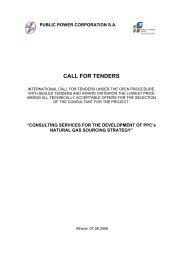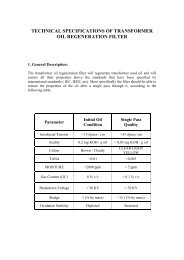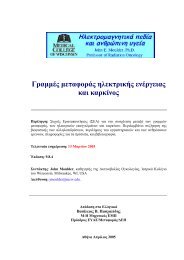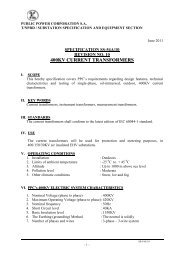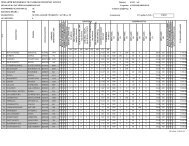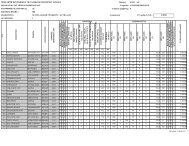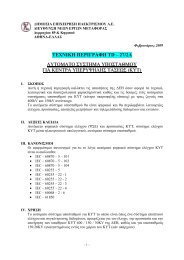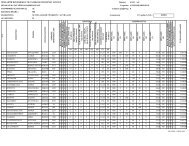Financial Report (January 1, 2010 - December 31, 2010)
Financial Report (January 1, 2010 - December 31, 2010)
Financial Report (January 1, 2010 - December 31, 2010)
Create successful ePaper yourself
Turn your PDF publications into a flip-book with our unique Google optimized e-Paper software.
PUBLIC POWER CORPORATION S.A. AND SUBSIDIARIESNOTES TO THE FINANCIAL STATEMENTSACCORDING TO INTERNATIONAL FINANCIAL REPORTING STANDARDSAS ENDORSED BY THE EUROPEAN UNION<strong>December</strong> <strong>31</strong>, <strong>2010</strong>(All amounts in thousands of Euro, unless otherwise stated - except for share and per share data)3.4 PRINCIPAL ACCOUNTING POLICIES (CONTINUED)Share capitalShare capital represents the par value of shares fully issued and outstanding. Any proceeds in excess of par valueare recorded in share premium. Expenses related directly to new shares issuance are recognized directly toEquity net of proceeds.De-recognition of financial assets and liabilities<strong>Financial</strong> ReceivablesA financial receivable (or, where applicable a part of a financial receivable or part of a group of similar financialreceivables) is derecognized where: (1) the rights to receive cash flows from the asset have expired, (2) PPCretains the right to receive cash flows from the asset, but has assumed an obligation to pay them in full withoutmaterial delay to a third party under a “pass-through” arrangement and (3) PPC has transferred its rights toreceive cash flows from the asset and either (a) has transferred substantially all the risks and rewards of theassets, or (b) has neither transferred nor retained substantially all the risks and rewards of the asset, but hastransferred control of the asset. Where PPC has transferred its rights to receive cash flows from an asset and hasneither transferred nor retained substantially all the risks and rewards of the asset nor transferred control of theasset, the asset is recognized to the extent of PPC’s continuing involvement in the asset. Continuing involvementthat takes the form of a guarantee over the transferred asset is measured at the lower of the original carryingamount of the asset and the maximum amount of consideration that PPC could be required to repay. Wherecontinuing involvement takes the form of a written and/or purchase option (including a cash-settled option orsimilar provision) on the transferred asset, the extent of PPC’s continuing involvement is the amount of thetransferred asset that PPC may repurchase, except that in the case of a written put option (including a cashsettledoption or similar provision) on an asset measured at fair value, the extent of PPC’s continuing involvementis limited to the lower of the fair value of the transferred asset and the option exercise price.<strong>Financial</strong> liabilitiesA financial liability is derecognized when the obligation under the liability is discharged or cancelled or expires.Where an existing financial liability is replaced by another from the same lender on substantially different terms, orthe terms of an existing liability are substantially modified, such an exchange or modification is treated as a derecognitionof the original liability and the recognition of a new liability, and the difference in the respective carryingamounts is recognized in profit or loss.Offsetting of financial assets and liabilities<strong>Financial</strong> assets and liabilities are offset and the net amount is presented in the balance sheet only when PPC hasa legally enforceable right to set off the recognized amounts and intends to either to settle such asset and liabilityon a net basis or to realize the asset and settle the liability simultaneously.Interest bearing loans and borrowingsAll loans and borrowings are initially recognized at cost, being the fair value of the consideration received net ofissue costs associated with the borrowing. After initial recognition, they are subsequently measured at amortizedcost using the effective interest rate method. Amortized cost is calculated by taking into account any issue costs.Provisions for risks and expenses, contingent liabilities and contingent claimsProvisions are recognised when the Group has a present legal, contractual or constructive obligation as a result ofpast events and it is probable that an outflow of resources embodying economic benefits will be required to settlethis obligation, and a reliable estimate of the amount of the obligation can be made. Provisions are reviewed ateach balance sheet date and adjusted to reflect the present value of the expenditure expected to be required tosettle the obligation. Contingent liabilities are not recognised in the financial statements but are disclosed unlessthe possibility of an outflow of resources embodying economic benefits is remote. Contingent assets are notrecognised in the financial statements but are disclosed when an inflow of economic benefits is probable.Post- retirement benefitsPPC’s employees and pensioners are entitled to supply of energy at reduced tariffs. Such reduced tariffs topensioners are considered to be retirement obligations and are calculated at the discounted value of the futureretirement benefits deemed to have accrued at year-end based on the employees earning retirement benefit rightssteadily throughout the working period. Retirement obligations are calculated on the basis of financial andactuarial assumptions. Net costs for the period are included in the payroll cost in the statements of income andconsist of the present value of the benefits earned in the year, decreased by the benefits offered to thepensioners. The retirement benefit obligations are not funded. Unrecognized gains or losses that exceed 10% of theprojected benefit obligation at the beginning of each period are recognized over the average remaining service periodof active employees and included as a component of net pension cost for a year.74




